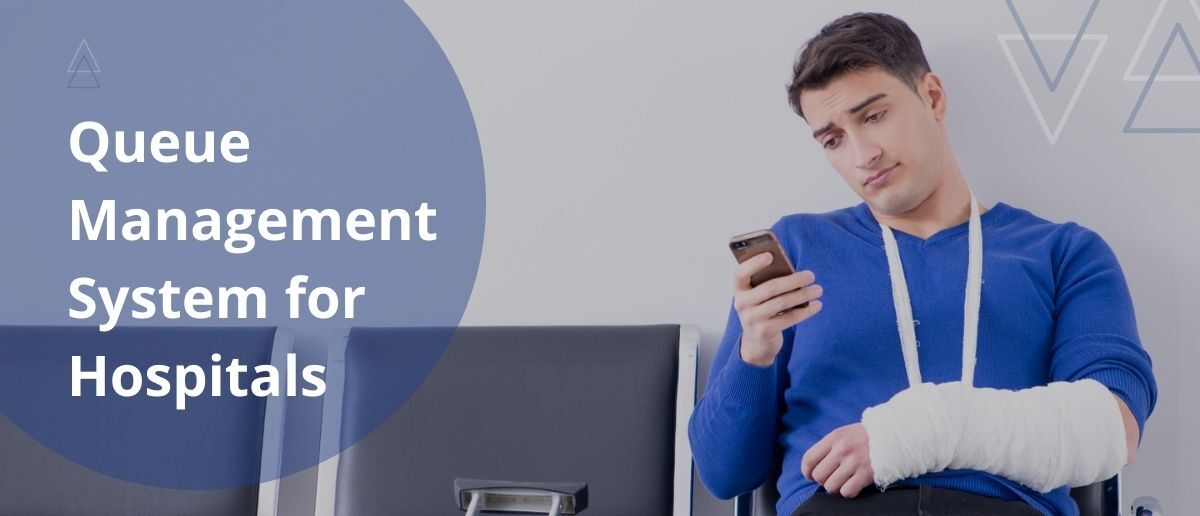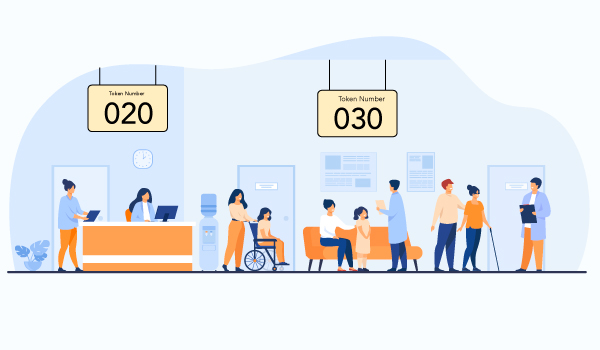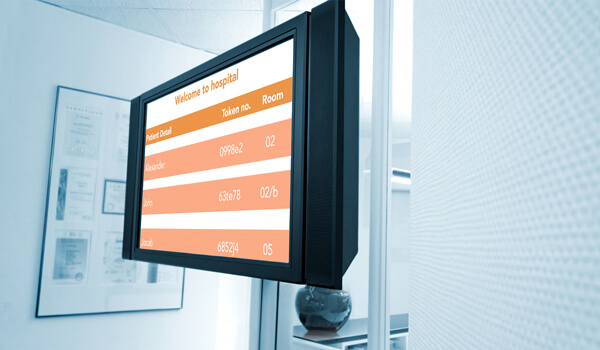
Apr 18 2022
10 min read


Patients are often anxious, stressed, and sometimes even in pain when visiting hospitals and clinics. As a result, hospitals must establish a welcoming environment. Healthcare facilities are under tremendous pressure to deliver better treatment to more patients while working with limited resources. For hospitals, in particular, this frequently results in a stressful environment for both patients and employees.
Generally, queues build up at healthcare facilities and cause a lot of frustration because services are delayed for significant periods. This causes patient discomfort leading to medical issues and sometimes chaos that could have been avoided.
The COVID-19 pandemic has demonstrated the importance of a patient flow management system that is both safe and efficient. With legislation requiring a safe distance and a limited number of people in an indoor space, healthcare institutions had to urgently adopt a digital ecosystem to sustain services while ensuring the safety of everyone (including patients, staff, and visitors).
Hospitals and clinics are increasingly focusing on delivering a smooth experience to their patients and efficient queue management has made it into the front page of their healthcare marketing strategy folio.

Queue management solutions work on the idea of quantifying the queue demand at any given time and informing your workforce in real-time. It shows the number of patients joining a queue, the number of patients waiting to be served, and their wait duration.
The flow of patients through hospitals and clinics is streamlined using a queue management system. It reduces patient wait times, avoids large lines, and provides information. Patients can join the queue virtually, using SMS, QR barcodes, a smartphone app, or a website booking system, with the help of a queue management system.
For example, Patient A arrives at the hospital in discomfort and does not want to stand in the queue to fill out the paperwork. The patient notices that the hospital has a QR code on a display. Patient ‘A’ scans the QR code on their phone and receives the token number. The patient can now wait in the waiting area or hospital cafeteria until their token number appears on the screen. Even if they miss noticing their token number on the digital signage, they will still be alerted by SMS or push notifications on their mobile phones.
That is how hospital administrations address the challenge of ‘patient experience.’
Queue management systems (QMS) have been utilized in the healthcare industry for a long time, albeit with limited use. Professionals across the business have become more reliant on such technology due to the COVID-19 outbreak. There are several ways clinics and hospitals can leverage a queue management solution.
The reason why queues build up in most hospitals is that the number of visitors and attendants at any given time is significantly out of proportion. But what if there was a decentralized reception to address multiple requests and queries simultaneously? The genius technology of self-service can make it all happen. When people can check-in remotely with an app or even join the queue using a self-service tablet or kiosk, it naturally accelerates the service and patient flow in the hospitals.
Once a patient joins a virtual queue, it is important that they are able to track their ticket status. The queue management software can be paired with all the digital signage screens across the premise, such as the cafeteria, the reception, the waiting rooms, the emergency departments, or the pharmacies. It creates a connected environment where patients can follow their soft tokens anywhere they go.
Queue management systems are as helpful for the hospital receptionists as they are to the patients. Front desk workers can keep track of the number of patients in line and the number of no-shows. With just a single click, they can reshuffle patient lists, update cancellations, close appointments and track the payment status. They can share the updated schedules with the doctors via a simple email or screenshot.
Since a lot of their work gets automated, they can focus on more important jobs like document processing, admission formalities, and patient queries. Both staff and patients are happier when they can focus more on the patient experience rather than crowd control.
When there is a shortage of personnel, optimizing resource allocation becomes a priority. A digital queue management software can deliver real-time reporting and analytics for critical decision-making, such as anticipating peak hours to maximize staff productivity or requesting more assistance. It also enables healthcare providers to limit the number of patients in an office at any given moment, boosting patients’ trust in the provider’s ability to safeguard their health and safety.

During the COVID-19 pandemic, emergency departments were one of the hardest-hit areas. Many patients hurried to the emergency room after being infected or fearing contamination. Hospital ERs were overburdened, and in a situation like this, triaging patient requirements and coordination between the front desk attendants and ER staff can become extremely difficult and vulnerable to errors.
A quality management system (QMS) can enable the triage room receptionists to segregate patients based on preliminary assessments and share that list with the ER staff in real-time. The ER staff can then take the final call, and the whole communication can be done electronically with the help of connected screens and digital signage software.

Time seems to fly by when you’re doing something you enjoy, but if you’re bored to tears, minutes might feel like hours. And what’s more tedious than standing in line? According to a study, 30% of patients who experience excessive wait times leave before seeing a doctor, and 20% switch healthcare providers entirely.
Dealing with a waiting patient can prove to be challenging if the patient flow is not managed properly. Here are some advantages of using a well-connected queue management system in healthcare facilities:
Dissipate the crowd: There are no conflicts when people join a virtual queue. It has two benefits; on the one hand, it can help stop the spread of any airborne or particle-borne infection, and on the other hand, it frees up the counters and the overworked staff.
Reduce patient frustration: According to reports, 43% of patients grow frustrated when their hospital wait time exceeds 20 minutes. A satisfied patient is ensured by reducing wait time, increasing service delivery efficiency, and a positive patient experience. A happy patient translates to a positive reputation. Especially in the healthcare industry, where most people consult with their family, friends, and co-workers before choosing a medical facility for treatment, word of mouth may be highly beneficial to your business.
Spread awareness: The screens showing patient queue status can also be used to provide important healthcare updates, such as reaffirming pandemic safety standards, hospital facilities, doctor’s lists, infotainment like news, weather, health & hygiene suggestions, and other important information. As part of a successful digital healthcare transformation strategy, virtual queueing can improve patient satisfaction.
Gather feedback: A queue management software can also collect reviews, ratings, and feedback from the patients while they check out of the hospitals and clinics.
Related Article: Why do hospitals and clinics need a digital signage system?
These are the three features that a smart queuing solution must have:
Your queue management system should allow patients the flexibility to join the queue or arrange an appointment from anywhere using a mobile device, website, or onsite kiosk.
Mobile tracking is another important feature in any queue management solution. Make sure your system sends regular notifications and reminders on the patients’ mobile phones. Also, the digital signage system on-premise that shows the soft tokens needs to be at par with the mobile tracking system.
Reporting features can range from simple network uptime/downtime to complex AI-driven data. A queue management software can be equipped with the necessary intelligence depending on your requirement.
A queue management system is not a showy gimmick that will help healthcare businesses to build their brand image or garner more popularity. It is an effective and practical solution to a very practical challenge faced by most hospitals and clinics worldwide. But that said, improving patient experience will naturally drive better results for the commercial interests as well. One thing is clear, even in the post-pandemic world, hospitals will remain a busy place, and deploying a queuing system will be a long-lived wise decision.
Pickcel’s Queue Management Solution can help your healthcare organization comply with social distancing requirements, enhance patient volumes, and improve patient satisfaction. Pickcel is a multi-award-winning digital signage software firm. We provide free digital signage guidance, lifetime software updates, and round-the-clock support.
To give your patients the experience they’ve always desired, sign up for a 14-day free trial of Pickcel’s Digital Signage Software.

Apr 18 2022
10 min read

Mar 17 2022
12 min read

Oct 22 2020
7 min read

Jan 1 2020
8 min read
Take complete control of what you show on your digital signage & how you show it.
Start Free Trial Schedule My Demo